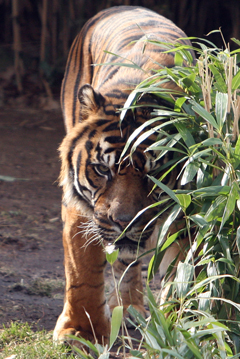WWF has attributed six recent killings of villagers by tigers to deforestation in Sumatra. Habitat loss — together with prey depletion by hunting — is believed to be driving tiger-human conflict on the Indonesia island.
WWF says the three latest victims — killed this past weekend in Jambi Province — appeared to be working at an illegal logging camp.
“As people encroach into tiger habitat, it’s creating a crisis situation and further threatening this critically endangered sub-species,” said Ian Kosasih, director of WWF’s Forest Program. “In light of these killings, officials have got to make public safety a top concern and put a stop to illegal clearance of forests in Sumatra.”
 Sumatran tiger. Photo by Rhett A. Butler. |
“The shocking news that six people have been killed in less than one month is an extremely sad illustration of how bad the situation has become in Jambi,” Wurjanto said. “It’s a signal that we need to get serious about protecting natural forest and giving tigers their space, and ensure local governments have sustainable economic development policies in place that include long-term protections for our natural resources.”
The Sumatran tiger is imperiled from ongoing habitat destruction — about half of Sumatra’s forests have been cleared in the past 25 years — as well as overhunting of its prey and poaching for the traditional Chinese medicine market. The Sumatran tiger is now down to about 450 individuals in the wild, making it one of the rarest subspecies of tiger. The Javan, Bali, and Caspain subspecies went extinct last century.
WWF is urging the provincial government to crack down on illegal logging and forest clearing in Jambi, but work in other areas has shown that reducing deforestation alone will not be enough to save the tiger. Improved wildlife law enforcement and programs to build sustainable livelihoods for local people and reduce tiger-human conflict through modified agricultural and animal husbandry practices will be critical to protecting the great cat from extinction in the wild.